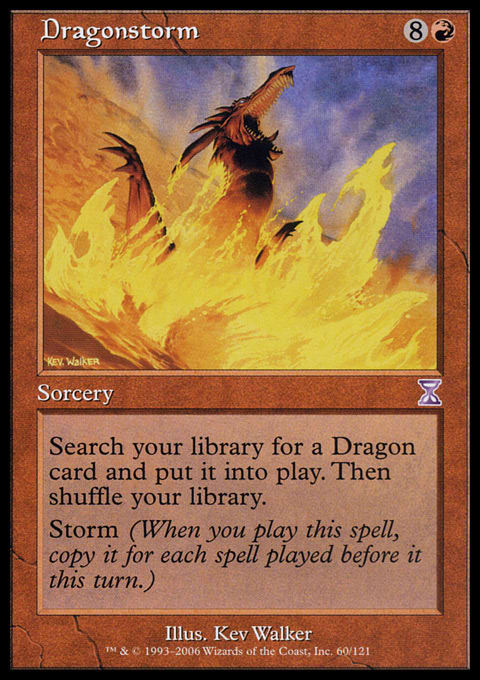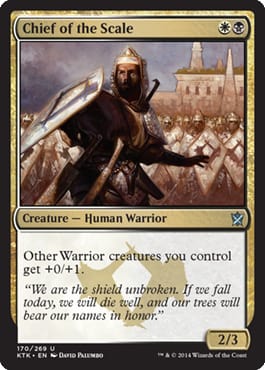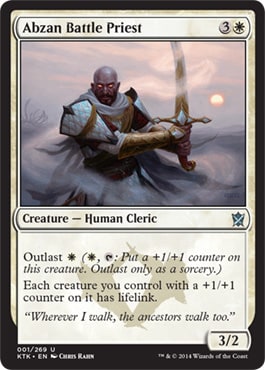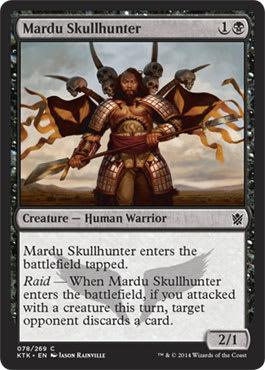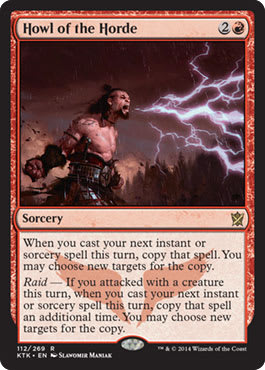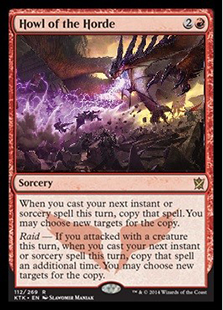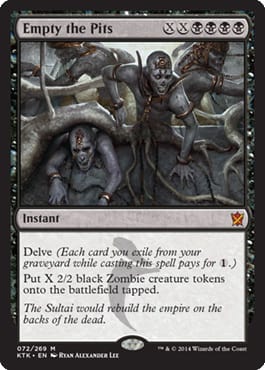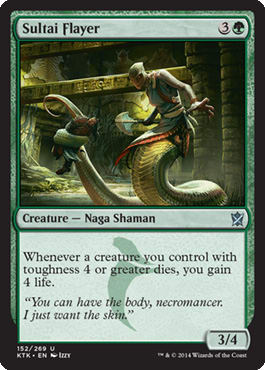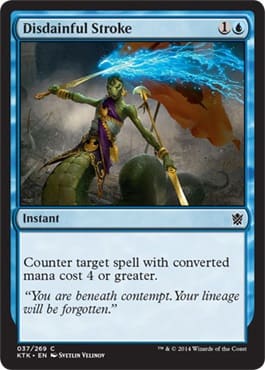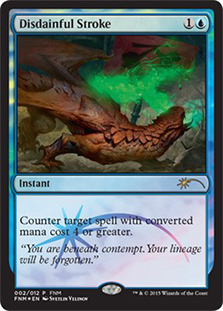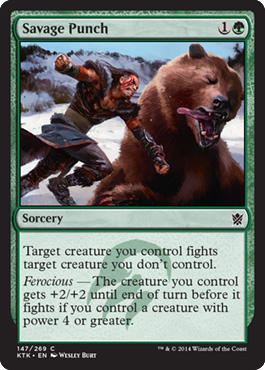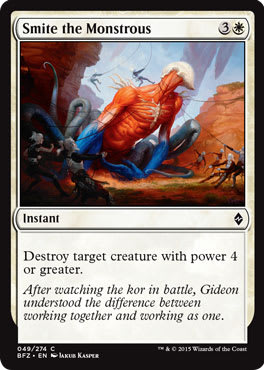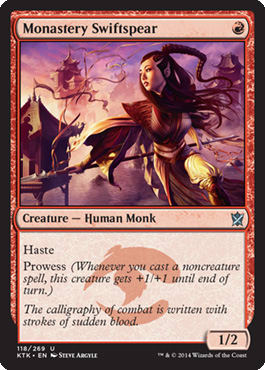Dragons of Tarkir is fast approaching. As we come closer to spoiler season for Fate Reforged, the Vorthos community has been buzzing with theories and speculations regarding Tarkir’s dragons. Due to the unique nature of this block, vital information about the details surrounding the plane of Tarkir have been kept secret from us in order to avoid spoiling information involved with the time-altering story. In this article, I have collected all of the pieces of information we have been given so far in order to try to determine the fate that awaits us in Dragons of Tarkir.
What We Know about Ugin
Before we get started throwing out wild speculations and theories, it is important to note the information we have been given up to this point. The dragons on Tarkir seem to be more or less linked directly to one individual in particular:
. . . Ugin.

In the Uncharted Realms article “Sorin’s Revelation,” the vampire Planeswalker makes a trek across the Temur wilderness in a desperate search for Ugin. Sorin reanimates a Temur warrior to serve as a guide across the harsh terrain in order to find the quickest path to where the spirit dragon was rumored to lie. Over the course of their travels together, Sorin asks his guide a number of questions regarding both Ugin and the (now extinct) dragons of Tarkir. His guide informs him that the dragons were a result of great storms. He explains that the clans fought together against the dragons until they became extinct, and that once there were no more dragons to fight, they simply turned on each other. These lines are important because they give us windows into the mindset of the Tarkir people, and they serve as a way for use to understand what is occurring in the setting. Let’s take the first line:
What did the Temur guide mean here when he said the dragons were a result of storms? There are two ways you can view this statement: literally or figuratively.
Figuratively Speaking
When Montezuma first heard of Cortez and his men approaching in their gigantic wooden ships with large white sails, they were described to him as “floating mountains” because the ancient peoples had never encountered a ship before, and they had no words to describe them. To Montezuma and his people, the arrival of the Spaniards could be compared to what it would be like for humans to experience an alien invasion. The way in which the Temur warrior describes the dragons of old makes me think that saying, “Dragons born of storms,” is Tarkir’s “floating mountains” in that the Tarkir people had no words to describe what they were seeing.
Perhaps the dragons born of storms were created by Ugin and were nothing more than different dragons summoned by the spirit dragon erupting out of morph energy. We know that the look of morphs is due to the fact that morph magic is an old, draconic form of magic that has been adopted by the clans, and if we look at Ugin in the art of Crux of Fate, the spirit dragon appears to be erupting out of what looks like a storm (or possibly a morph cloud).
If we decide to use this line of thinking, what does this tell us about the future sets? The simplest answer is often the best one: All the morph cards in Fate Reforged—and possibly in Dragons of Tarkir—will be dragons. We know the clans adopted morph magic from an ancient form of draconic magics and that the ancient dragons were described as emerging from storms. This can easily be showcased in the mechanics of the past in Fate Reforged by showing dragons erupt out of morph storm shells. By having only dragons be able to morph, it can show a time when the clans had yet to understand and adopt the ability to do so.
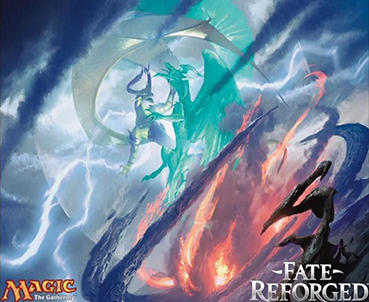 |
 |
Literally Speaking
If we assume that the people of Tarkir do in fact have the words to describe exactly what they saw when the dragons were forming out of great storms, we can assume that is literally what happened. If we use this approach, there is not much we can ascertain about the dragons other than that they were created from a storm. What this does is possibly give us a little background on Ugin. Perhaps the spirit dragon uses the following in its arsenal of spells:
. . . And the Tarkir dragons are simply the result of it. This would help to explain why, once Ugin died, the dragons could be hunted to extinction. Without a Planeswalker summoning them in great storms, the magical creatures were destined to die out. What I do not like about this theory is that in order for it to be true, Ugin would have to continually cast Dragonstorm on Tarkir forever if the plane wanted to always have dragons.
What We Know about the Abzan
The Abzan as a clan reveres the endurance of the dragon, taking the dragon scale as its clan symbol. This belief carries over into the visual appearance of the clan by showcasing members clad in heavy, scale armor.
A card featuring the Abzan from Fate Reforged was spoiled recently:

This card gives us three very important pieces of information: the art, the mechanics, and the flavor text.
Looking at the art, we can clearly see a dragon. This particular dragon has thick, diamond-shaped scales and an extremely dense-looking skull. In many ways, this dragon looks very similar to the armored dinosaur Ankylosaurus.

Original image found here.
This is not a coincidence. At this point, we have seen multiple variations on the dragons shown in Tarkir art (more on this in a minute). Everything about the dragon depicted here showcases a form of the dragon that epitomizes endurance. Hmm. Endurance. Where have we heard that before? The Abzan as a clan reveres the endurance of the dragons. Perhaps they revered this type of dragon in particular. From now on, I will be referring to the type of dragon pictured on Valorous Stance as an Abzan dragon.
Looking at the mechanics, we have a choice spell. Looking at Crux of Fate and this card, it appears there might be a higher-than-normal number of choice cards in Fate Reforged, which is awesome because it perfectly plays up the storyline involving Sarkhan and the choice he has to make. For this card, the choice is between two very different modes: Kill something large or save something (most likely from death)—interesting. Looking back up at the art, we can clearly see that the warrior pictured is the one casting the spell and that said warrior belong to the Abzan clan.
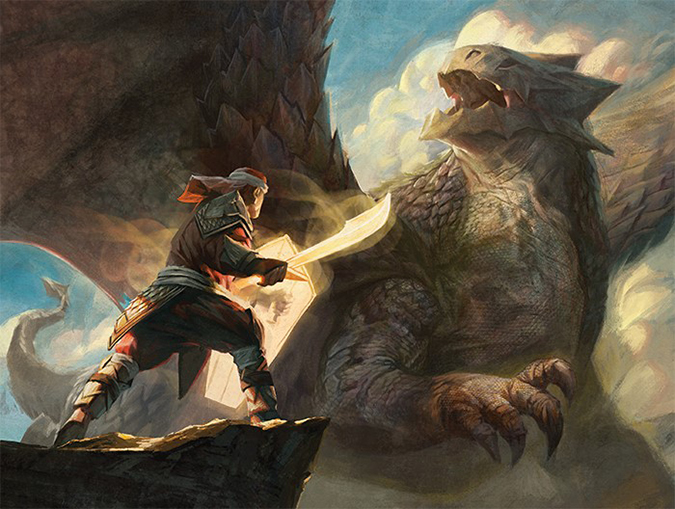
If we look at the dragon pictured, it seems to be reeling back, almost as if it were in pain. This piece can be viewed in one of two ways:
- The Abzan warrior was fighting this dragon and is about to (destroy target creature with toughness 4 or greater) land the killing blow.
- The Abzan warrior encountered an Abzan dragon and decided (target creature gains indestructible until the end of turn) to save the creature from death.
That’s an interesting choice, no?
Looking at the flavor text, we have a quote from Sarkhan himself:
That Sarkhan, always so direct and to the point. Perhaps what our slightly crazy shaman is trying to tell us is that this card also represents a turning point. If the Abzan warrior decides to strike down this dragon, perhaps the dragons will eventually become extinct and Tarkir as we know it will remain the same. But what if the warrior decides to show compassion and save this creature, deciding to protect it instead? What effect could that have on the fate of the world? To answer that, we need to move on to our next clan.
What We Know about the Mardu
The Mardu as a clan reveres the speed of the dragon, taking the dragon wings as its clan symbol. This belief carries over into the visual appearance of the clan by showcasing them constantly moving, with banners flapping in the breeze as a symbolic form of wings.
When Dragons of Tarkir was announced, the following piece of art was used to headline the reveal:
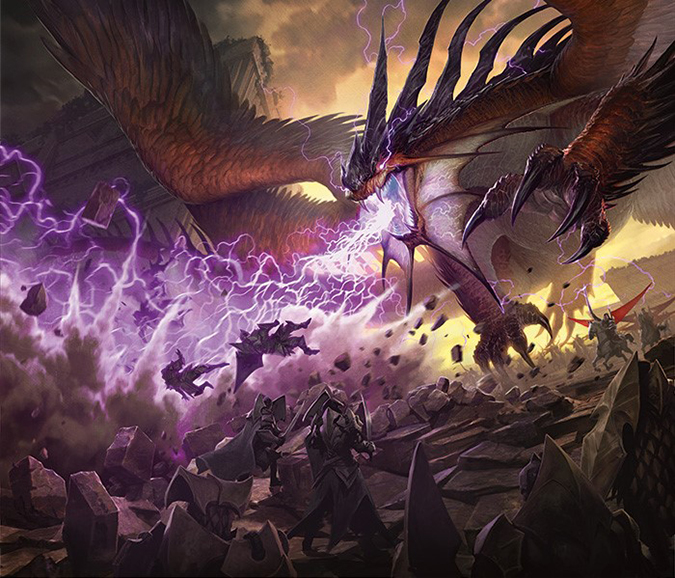
Let’s stop for a second and compare the dragon shown here to the Abzan dragon pictured above. Notice anything different? This dragon has feathers, has spines on its head, and breathes lightning, but most importantly, this dragon has two sets of wings. Why is that? Again, this is not on accident. The Mardu reveres the speed of the dragon, and its symbol is a pair of dragon wings. Perhaps this type of dragon has multiple wings that allow it to be an extremely fast flyer. Everything about this piece above promotes an idea of quickness and speed. Its face is more lithe and snakelike. Interesting that snakes are also known for their lightning-quick striking ability. Did I say lightning? Interesting. This dragon appears to be the epitome of speed. Moving forward, I will be referring to it as a Mardu dragon.
Another extremely interesting part of this art is showcased through the small figures running below the dragon. See those warriors on horseback? They look an awful lot like Mardu warriors, don't they? But why would a large group of Mardu warriors be fighting alongside a dragon instead of against it? Going back to what we were discussing above with Valorous stance, I proposed the question:
What if, instead of killing off all of the dragons, an as-of-yet-to-be-determined incident happened that caused the five clans to befriend the types of dragons they revered most? What if the Abzan fought alongside its endurance dragons against the lightning-quick Mardu horde and its speed dragons? Perhaps in seeing Sarkhan save Ugin from a grisly fate at the hands of Bolas, the khans of Tarkir decided that they too would show compassion for their scaly plane-mates. If you look at the banners flying behind the Mardu riding in this picture, they are not the tattered flags tied to dragon bones we see on Tarkir, but instead are flags held taut on thin, black, spine-like protrusions. Perhaps these are meant to mimic the protrusions seen surrounding the jaw of the dragon they fight beside. These warriors seem to be reversing this beast as it unleashes a powerful howl of the horde:
The final part of this art that I find so interesting is that the Mardu dragon has thick, black spines running down the back of its skull. Where have we seen this before?

That’s right! Zurgo, in all his smug glory, has been seen sitting on a throne crafted from the skull of a dragon—but not just any dragon! This throne seems to have been made from the skull of the Mardu dragon pictured above. What an interesting contrast to the Dragons of Tarkir reveal art. On one side, we have the skull of the dragon being defaced by the Mardu clan, while on the other side of fate, we see that same dragon fighting that same clan.
So far, we have seen two very different dragon types that seem to be tied to particular clans. But can we safely assume this will be true for all of the clans? Let’s move on to the next clan on our list to find out.
What We Know about the Sultai
The Sultai as a clan reveres the ruthlessness of the dragon, taking the dragon fangs as its clan symbol. This belief carries over into the visual appearance of the clan by showcasing them performing such ruthless actions as raising the dead to fight for them or giving Jeskai warriors a diving lesson:
What we can learn about the Sultai dragons comes from three cards (two of which are the same card with alternate art).
In the card art for Disdainful Stroke seen in Khans of Tarkir, we see a Sultai naga cutting an Abzan banner with some form of magical energy. This is an extremely important detail. When we look at the card art for the promo version of Disdainful Stroke, we can see a dragon breathing some form of magical energy that is (again) destroying an Abzan banner.
These two scenes are completely identical other than one simple change. Instead of the Sultai naga, we see a dragon, possibly a Sultai dragon. If we look closely at the dragon in the art, we can see huge, fang-like spikes coming out of the side of the dragon’s open mouth. Perhaps these fangs are what inspired the Sultai clan symbol, similar to the scales and wings discussed above. If we look at the dragon shown on Dig Through Time and compare it to the dragon shown in the promo art, we can note some similarities in both shape and structure of the two dragons.
These facts lead me to believe that the dragon pictured in the promo art is in fact the Sultai dragon that will be fighting alongside the clan come Dragons of Tarkir. The fact that the dragon and the naga are the only things different about the two pieces of art is interesting; is that true for the other alternate-art promos? Let’s move on to our next clan and dig deeper.
What We Know about the Temur
The Temur as a clan reveres the savagery of the dragon, taking the dragon claws as its clan symbol. This belief carries over into the visual appearance of the clan by showcasing them as harsh inhibitors of the fierce wilderness on Tarkir. Also they punch bears—to death.
For the Temur, we can look to the card Smite the Monstrous, both as it appears in Khans of Tarkir and its alternate-art promo:
Similar to how we had the exact same scene taking place on both Sultai cards pictured above on Disdainful Stroke, here we have again the exact same background in each version of Smite the Monstrous. See the icy cliff each victim is falling off? See the cloudy ice mountains in the background? Again, they’re too similar to be accidental. Also just like above, the artist on these two cards is the same. If we look at the Tarkir version, we see a loxodon being speared through the gut by a shaft of white light. Looking at this loxodon, I think we can safely assume it is a member of the Temur.
If we go by Disdainful Stroke as our example, that would mean the dragon replacing this Temur loxodon would also have to be Temur-flavored. (I don’t know about you, but I wouldn't want to eat anything Temur-flavored. Yuk!)
If we look closely at the dragon pictured in Smite the Monstrous, it appears that it has a hairy (possibly woolly) back and antlers, which both play up the look and feel of the Temur. Also, if we look at the dragon’s claws, they appear to be oversized and particularly savage-looking. Comparing the shape of this dragon’s skull to the one shown in Frontier Bivouac leads me to believe that we are looking at the Temur dragon that will be showcased in Dragons of Tarkir. That leaves us with four of the five dragons covered, but what about the Jeskai?
What We Know about the Jeskai
The Jeskai as a clan reveres the cunning of the dragon, taking the dragon eye as its clan symbol. This belief carries over into the visual appearance of the clan by showcasing its members as serene monk-warriors—and also the fact that they paint eye symbols on their heads:
As of yet, we have not seen much that would point us in the direction of what the Jeskai dragons may look like, but some have speculated that a relic of the dragons’ past can be seen in Chase Stone’s art for Bloodfire Mentor:
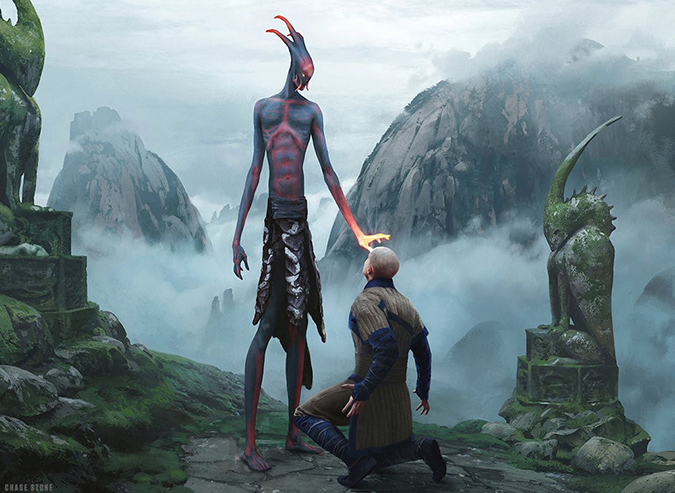
We can see, to the right, a statue of a creature that we have yet to encounter on Tarkir. Could this creature with a long, protruding skull-horn be a Jeskai dragon? Perhaps the Jeskai members have eyes on their foreheads because the dragons of old had third eyes?
TL;DR
I believe the following things will be true of Fate Reforged:
- All morph creatures will be dragons.
- The clans will decide to befriend their respective dragon types instead of killing them.
I believe the following things will be true about the dragons of Tarkir:
- There will be five different dragon types, one for each clan.
- The Abzan dragons will have two wings and be shaped like Ankylosaurus.
- The Mardu dragon will have four, feathered wings and be extremely fast.
- The Sultai dragons will have large fangs protruding from the sides of their mouths—and will have counterspell breath!
- The Temur dragons will have antlers, woolly–mammoth-esque hair, and large claws.
- The Jeskai dragons will have single, large horns protruding from the tops of their skulls and will have third eyes in the middles of their heads.
- The clans will fight alongside their dragons against the other clans, gaining power from their new dragon friends.
What do you think? Let me know in the comments!
















